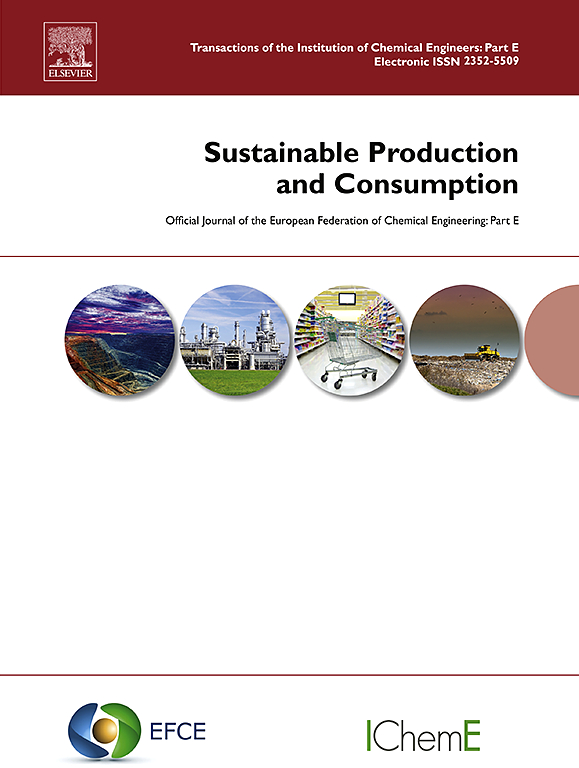Environmental performance of second-life lithium-ion batteries repurposed from electric vehicles for household storage systems
IF 10.9
1区 环境科学与生态学
Q1 ENVIRONMENTAL STUDIES
引用次数: 0
Abstract
Repurposing lithium-ion batteries has proven to be a promising solution to address the rising number of end-of-life batteries that can be used for second-life energy storage systems and thus extend their service life. While previous research has provided valuable insights into the environmental benefits of battery repurposing, there is still a need to examine the repurposing process more thoroughly, in order to make well-informed decisions on the implementation of second-life battery storage systems. Therefore, this study examines the influence of different repurposing strategies on the environmental performance of second-life battery energy storage systems. A life cycle assessment was conducted, analysing four repurposing cases relating to the exchange of components, namely i) new battery management system and module casing (Base case), ii) new battery management system and reuse of module casing (Case 1), iii) new module casing and reuse of battery management system (Case 2) and iv) reuse of module casing and battery management system (Case 3). These impacts were compared to a storage system with new batteries, to determine the potential environmental benefits and identify the most suitable repurposing strategy. Our findings demonstrate significant environmental benefits of second-life battery energy storage systems across various impact categories and repurposing cases. The Base case and Case 1 resulted in environmental benefits across all impact categories. The highest benefits were observed for metal depletion with savings of 58 % and 61 %, respectively. Increased savings were obtained for Case 2 and Case 3. However, environmental drawbacks were identified for freshwater and marine ecotoxicity. In particular, Case 2 resulted in the highest drawbacks of −22 % and −16 %, respectively. These can be attributed to the allocation procedure, particularly affecting the recycling credits of battery management system recycling. The full allocation of end-of-life impacts and consequently the recycling credits to the second-life battery has not only led to a substantial increase in overall savings, but also resulted in impact categories that originally had disadvantages becoming those with the highest environmental savings. This study demonstrates the importance of carefully selecting repurposing strategies for second-life energy storage systems to maximize their environmental benefits and avoid drawbacks. Additionally, the results highlight the substantial influence of allocation procedures on overall environmental impacts, underscoring the need for clearer methodological guidance on addressing the multifunctionality of repurposed batteries.
从电动汽车改装为家庭存储系统的二次寿命锂离子电池的环境性能
锂离子电池的再利用已被证明是一个很有前途的解决方案,可以解决越来越多的报废电池的问题,这些电池可以用于二次储能系统,从而延长其使用寿命。虽然以前的研究已经为电池再利用的环境效益提供了有价值的见解,但仍然需要更彻底地检查再利用过程,以便在实施二次使用电池存储系统时做出明智的决定。因此,本研究考察了不同再利用策略对二次寿命电池储能系统环境性能的影响。进行了生命周期评估,分析了与组件交换有关的四个再利用案例,即i)新的电池管理系统和模块外壳(基本案例),ii)新的电池管理系统和模块外壳的再利用(案例1),iii)新的模块外壳和电池管理系统的再利用(案例2)和iv)模块外壳和电池管理系统的再利用(案例3)。这些影响与具有新电池的存储系统进行了比较。确定潜在的环境效益,并确定最合适的再用途策略。我们的研究结果表明,在各种影响类别和再利用案例中,二次电池储能系统具有显著的环境效益。基本情况和情况1在所有影响类别中都产生了环境效益。对金属耗损的最大效益分别为58%和61%。案例2和案例3获得了更多的节省。然而,在淡水和海洋生态毒性方面存在环境缺陷。特别是,案例2的最大缺陷分别为- 22%和- 16%。这些可归因于分配程序,特别是影响电池管理系统回收的回收信用。对报废影响的充分分配,以及对二次寿命电池的回收信用,不仅导致了总体节约的大幅增加,而且还导致了最初不利的影响类别成为环境节约最高的影响类别。本研究证明了仔细选择二次寿命储能系统的再利用策略以最大化其环境效益和避免缺点的重要性。此外,研究结果强调了分配程序对总体环境影响的重大影响,强调了在处理再利用电池的多功能性方面需要更明确的方法指导。
本文章由计算机程序翻译,如有差异,请以英文原文为准。
求助全文
约1分钟内获得全文
求助全文
来源期刊

Sustainable Production and Consumption
Environmental Science-Environmental Engineering
CiteScore
17.40
自引率
7.40%
发文量
389
审稿时长
13 days
期刊介绍:
Sustainable production and consumption refers to the production and utilization of goods and services in a way that benefits society, is economically viable, and has minimal environmental impact throughout its entire lifespan. Our journal is dedicated to publishing top-notch interdisciplinary research and practical studies in this emerging field. We take a distinctive approach by examining the interplay between technology, consumption patterns, and policy to identify sustainable solutions for both production and consumption systems.
 求助内容:
求助内容: 应助结果提醒方式:
应助结果提醒方式:


